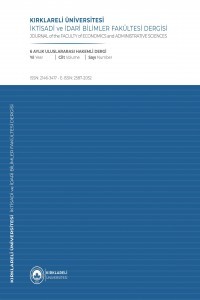Türkiye’de 2000-2021 Döneminde Kamu Mali Göstergelerinin Performans Analizi
Ekonomilerin yıllar içerisindeki durumunu gözlemleyebilmek için performanslarının doğru bir şekilde analiz edilmesi gerekmektedir. Birden fazla kriter ile yapılan makroekonomik performans analizleri daha geniş bir perspektiften yorum yapma imkânı vermektedir. Bu çalışmanın amacı Türkiye Ekonomisinin kamu mali görünümünün 2000-2021 dönemindeki performansını analiz etmektir. Türkiye’nin makroekonomik performansına yönelik çalışmalar olmasına rağmen, kamu mali performansına yönelik bir çalışmaya rastlanmamıştır. Performans analizinde COPRAS (Complex Proportional Assessment) yöntemi tercih edilmiştir. Türkiye’nin kamu mali performansı yedi kriter ile analiz edilmiştir. Bu kriterler; merkezi yönetim bütçesi net borçlanma gereği/GSYİH, Avrupa Birliği tanımlı genel yönetim borç stoku/GSYİH, faiz dışı denge/GSYİH, faiz harcamaları/konsolide bütçe giderleri, mahalli idareler net borçlanma gereği/GSYİH, dolaylı vergiler/toplam vergi gelirleri, genel bütçe vergi gelirleri tahsilat oranlarıdır. Yapılan performans analizi sonucunda Türkiye’nin 2000-2021 döneminde kamu mali performansının en kötü olduğu yıl 2001 olurken, en yüksek puana sahip yılın 2011 olduğu görülmüştür. Özellikle 2000-2009 dönemindeki performans puanlarının diğer yıllara göre daha düşük olduğu anlaşılmıştır.
Anahtar Kelimeler:
Kamu Mali Performans, Çok Kriterli Karar Verme, COPRAS
Performance Analysis of Public Finance Indicators for the Period 2000-2021 in Turkey
In order to observe the state of economies over the years, their performance should be analyzed accurately. Macroeconomic performance analyzes with more than one criterion provide the opportunity to comment from a broader perspective. The aim of this study is to analyze the performance of the public finance outlook of the Turkish economy in the 2000-2021 period. Although there are studies on Turkey's macroeconomic performance, no study on public financial performance has been found. The COPRAS (Complex Proportional Assessment) method was preferred for performance analysis. Turkey's public finance performance was analyzed with seven criteria. These criteria are; central government budget net borrowing requirement/GDP, European Union Defined General Government Debt Stock/GDP, Primary Balance/GDP, Interest Expenditures/Consolidated Budget Expenditures, Local Governments Net Borrowing Requirement/GDP, Indirect Taxes/Total Tax Revenues, General Budget Tax Revenue Collection Rates, Education. As a result of the performance analysis, in the 2000-2021 period of Turkey, the public financial performance was the worst in 2001, and the year with the highest score was 2011. It was understood that the performance scores especially in the period of 2000-2009 were lower than the other years.
___
- Al İ., Demirel, S. K. (2022). Türkiye'nin Makroekonomik Performansının TOPSIS Yöntemiyle Değerlendirilmesi: 2002-2019 DÖNEMİ. Mehmet Akif Ersoy Üniversitesi İktisadi ve İdari Bilimler Fakültesi Dergisi, 9(1), 202-222.
- Ball, L. M., & Mankiw, N. G. (1995). What Do Budget Deficits Do? NBER WORKING PAPER SERIES, Working Paper 5263. Celasun, O., Ostry, J. D., & Debrun, X. (2006). Primary Surplus Behavior And Risks To Fiscal Sustainability In Emerging Market Countries: A “fan-chart” Approach. IMF Staff Papers, 53(3), 401-425.
- Chattopadhyay, S., & Bose, S. (2015). Global Macroeconomic Performance: A Comparative Study Based On Composite Scores. Journal of Reviews on Global Economics, 4, 51-68.
- Doğan, H. (2022). Türkiye’nin Makroekonomik Performansının 2010-2020 Yılları İçin CRITIC Temelli ARAS Yöntemi İle Değerlendirilmesi. Asya Studies, 6(19), 189-202.
- Eleren, A., & Karagül, M. (2008). 1986-2006 Türkiye Ekonomisinin Performans Değerlendirmesi. Yönetim ve Ekonomi Dergisi, 15(1), 1-14.
- Gelir İdaresi Başkanlığı (2022). Bütçe Gelirleri (1923-2021), https://www.gib.gov.tr/sites/default/files/fileadmin/user_upload/VI/GBG1.htm
- Gül, Z. B. (2013). Türkiye’de 2000 Sonrası Dönemde Kamu Maliyesi Uygulamalarının Bölüşüm Etkilerinin Sosyal Hesaplar Matrisi (SHM) ile Analizi. Akdeniz İİBF Dergisi, 13(26), 77-102.
- Kete, H. & Karasaç, F. (2022). Covid-19 Sürecinde Avrupa Birliği Ülkeleri ve Türkiye’nin Ekonomik Performanslarının COPRAS Yöntemi ile Değerlendirilmesi. Journal of Economic Policy Researches, 9(2), 373-395.
- Öksüzkaya, M., & Yaşar, Z. R. (2022). Avrupa Birliği Ülkeleri ve Türkiye’nin 2016–2020 Yılları Arası Makroekonomik Performansının ARAS ve COPRAS Yöntemleri ile Karşılaştırılması. Ankara Hacı Bayram Veli Üniversitesi İktisadi ve İdari Bilimler Fakültesi Dergisi, 24(1), 171-198.
- Öniş, Z. (2003). “The Broader Ramifications of Turkey’s Financial Crises” The Turkish economy in crisis (Ed) Öniş, Z., Rubin, B. FRANK CASS, London.
- Podvezko, V. (2011). The Comparative Analysis Of Mcda Methods Saw And Copras. Engineering Economics, 22(2), 134-146.
- Rodrik, D. (2012). The Turkish Economy After The Global Financial Crisis. Ekonomi-tek, 1(1), 41-61.
- Şanlısoy, S., & Çeti̇n, M. (2016). Türkiye Ekonomisinde Hükümetlerin Ekonomik Performanslarının TOPSIS Yöntemi ile Ölçülmesi. Sosyoekonomi, 24(28), 65-84.
- Şimşek, A. (2006). Kamu Mali Dengesinin Sağlanmasında Maliye Politikasının Rolü: 2000 Sonrası Türkiye Deneyimi. Dokuz Eylül Üniversitesi Sosyal Bilimler Enstitüsü Dergisi, 8(3).
- T.C. Cumhurbaşkanlığı, Strateji ve Bütçe Başkanlığı, (2022). https://www.sbb.gov.tr/yillar-bazinda-genel-devlet-istatistikleri/
- Yılmaz, B. E. (2016). Maliye, 2. Basım, İstanbul: Der Yayınları.
- Zavadskas, E. K., Kaklauskas A., Sarka, Vaidotas (1994), The new method of multicriteria complex proportional assessment of projects, Technological and Economic Development Of Economy 1(3), 131-139.
- Zavadskas, E. K., Kaklauskas, A., Peldschus, F., ve Turskis, Z. (2007). Multi-Attribute Assessment Of Road Design Solutions By Using The COPRAS Method. The Baltic Journal of Road and Bridge Engineering, 2(4), 195-203.
- Zavadskas, E. K., Kaklauskas, A., Turskis, Z., & Tamošaitienė, J. (2009). Multi-Attribute Decision-Making Model By Applying Grey Numbers. Informatica, 20(2), 305-320.
- ISSN: 2146-3417
- Yayın Aralığı: Yılda 2 Sayı
- Başlangıç: 2012
- Yayıncı: Kırklareli Üniversitesi
Sayıdaki Diğer Makaleler
Sosyal Demokratların Göçmenlere Yaklaşımı: Türk ve Alman Örnekleri
Eric Hoffer. (2019). Kesin İnançlılar. (Çev.) Erkıl Günur. İstanbul: Olvido Kitap.
Duraklama ve Gerileme Dönemi Osmanlı Siyasetnamelerinde Devletin Hazinesine İlişkin Tespitler
Tüketici Davranışı Analizinde Büyük Verinin Kullanımı: Nitel Bir Çalışma
Anıl DEĞERMEN, Maryam MOHAMMADABBASİ
Adewale BEKE, Chidi Patrick NWAFOR, Charity Gwandzang ISA
Türkiye’de 2000-2021 Döneminde Kamu Mali Göstergelerinin Performans Analizi
